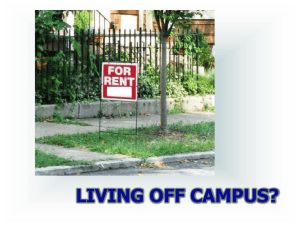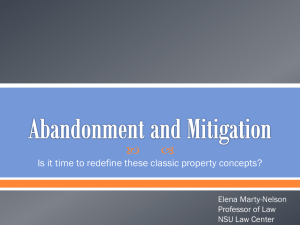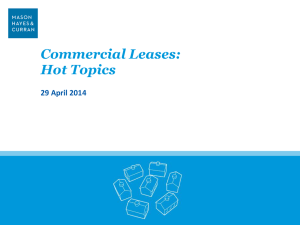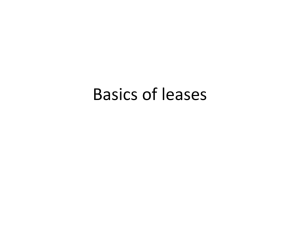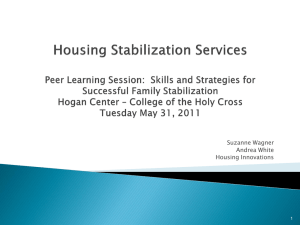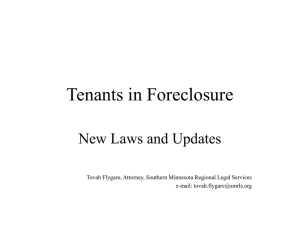DOCS1-#2112830-v1-LEXPERT_
advertisement
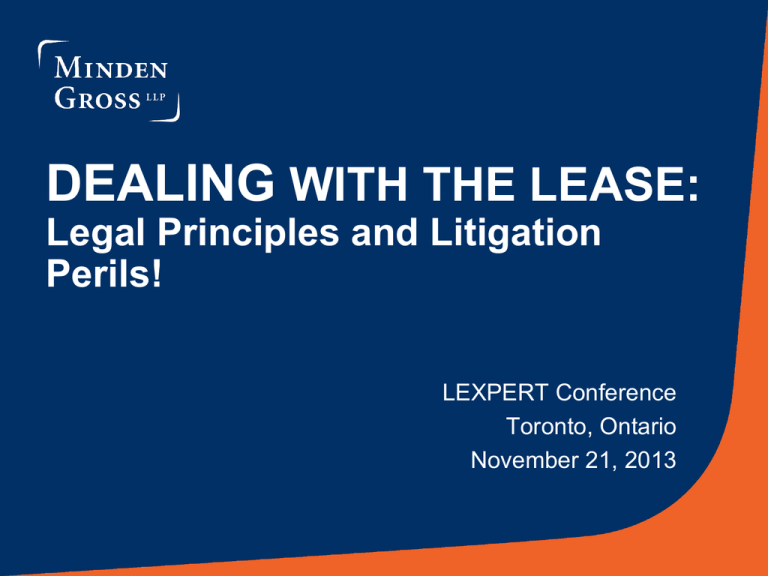
DEALING WITH THE LEASE: Legal Principles and Litigation Perils! LEXPERT Conference Toronto, Ontario November 21, 2013 Everything You Need to Know is in the Lease: NOT! Important Relevant Considerations Which Impact the Lease 1. Environmental – Holes in Lease? • Both landlords and tenants must be concerned with environmental obligations when entering into a lease. • Be clear regarding apportionment of environmental liability, including contamination and remediation. 1. Environmental – Holes in Lease? • Ambiguity in leases leads to disputes. To avoid uncertainty and disputes, commercial leases should clearly deal with: 1. Due Diligence: benchmark regarding condition of premises, building, soil and groundwater (Phase I or Phase II ESA); 1. Environmental – Holes in Lease? 2. Covenants: allocation of responsibility (i.e., who is responsible for what?) 3. Indemnity: allocation of environmental liability (including applicable standard at end of term) 1. Environmental – Holes in Lease? Lease should address the CONDITION of the Premises: as of the date of the Lease? the Possession Date? the Commencement Date? during the Term at expiry / termination of Lease 1. Environmental – Holes in Lease? What kind of obligations are captured by the generic “compliance with environmental laws” covenant in the Lease? Here are some examples (but this list is not exhaustive). • • • • Environmental Protection Act (Ontario) (EPA); Ontario Water Resources Act (OWRA); Waste Management Act; Canadian Environmental Protections Act (CEPA); 1. Environmental – Holes in Lease? • O. Reg. 278/05 (Designated Substance – Asbestos on Construction Projects and in Buildings and Repair Operations). • Clean-up standards and rules have been codified under the EPA and the Record of Site Condition regulation (O. Reg. 153/04). • Ontario’s Brownfields regulatory regime regulates the clean-up and redevelopment of contaminated sites. The latest elements were proclaimed in force effective July 1, 2011. 1. Environmental – Holes in Lease? For Landlord’s protection, the Lease should deal with: • prohibited uses should include hazardous substances (broadly defined) • Tenant covenant to COMPLY with all environmental laws • Energy conservation - Tenant covenant to comply with practices or procedures that Landlord may introduce 1. Environmental – Holes in Lease? • Tenant to NOTIFY Landlord regarding new contamination and/or spills, leaks, etc. • Landlord’s right to INSPECT and demand Tenant clean-up/remediation • Tenant’s INDEMNITY – for anything not released by Landlord • Landlord’s RELEASE – for anything not released by Landlord 1. Environmental – Holes in Lease? • Tenant to obtain environmental liability INSURANCE • Where Premises contains ASBESTOS (e.g., drywall joint compound), Lease should include Tenant acknowledgement of receipt of report disclosing suspected locations and covenant that if any removal, containment or skimming is required within the Premises to commence and/or complete any Tenant’s Work, same shall be performed as part of Tenant’s Work in compliance with laws (including all occupational health and safety laws) and Landlord shall have a right to inspect and supervise. 1. Environmental – Holes in Lease? For Tenant’s protection, the Lease should deal with: • Landlord representations and warranties • Release of Tenant for pre-existing contamination • Landlord covenants to clean up pre-existing contamination and subsequent contamination not caused by Tenant….and Landlord indemnity 1. Environmental – Holes in Lease? • ***3RD Party Contamination: Landlord covenant to remediate and/or Landlord indemnity • Landlord to NOTIFY Tenant regarding discovery, spill, leak, etc. and government action 2. Planning Act (Ontario) • Under Ontario’s Planning Act, Section 50(3) prevents one from entering into an agreement granting the right in land, directly or by entitlement to renewal, for a period of 21 years or more unless it falls into one of the statutory exceptions (s. 50(3) (a) to (g)). 2. Planning Act Statutory exceptions to Section 50(3): • 50(3)(a): where leased land is described in accordance and is within a registered plan of subdivision • 50(3)(b): where the Landlord does not own any land which abuts the leased land 2. Planning Act • 50(3)(c): where Her Majesty in Right of Canada, Her Majesty in Right of Ontario or any municipality is either landlord or tenant • 50(3)(f): a transaction that has received Consent 2. Planning Act Another important exception Section 50(9) – Part of building or structure: “Nothing in [Section 50(3)] prohibits the entering into of an agreement that has the effect of granting the use of or right in a part of a building or structure for any period of years.” 2. Planning Act Beware of Non-Compliance with the Planning Act!.... An agreement in contravention of s. 50(3) does NOT create or convey interest in land unless the Lease clearly states that if the Planning Act consent is required then the term is deemed to be 21 years less a day until Planning Act consent is obtained. 3. Occupational Health and Safety Act (Ontario) • Joint Occupancy: sample clause: “If the Landlord’s Work is not complete on the Scheduled Delivery Date then the Landlord may have access to the Premises to perform the Landlord’s Work. The Tenant acknowledges that if the contractors of the Tenant and the Landlord… 3. Occupational Health and Safety Act … are working in the Premises concurrently, such contractors must adhere to the OHS Act and the rules of joint occupancy associated with maintaining time and space separation between them.” 3. Occupational Health and Safety Act • Facilities: sample clause: “Fully equipped washroom facilities for male and female employees of the Tenant in accordance with the requirements established by the Occupational Health and Safety Act, R.S.O., 1990, c.0.1, as amended and the regulations made thereunder or any successor act…” 3. Occupational Health and Safety Act • “designated substances” means a biological, chemical or physical agent or combination thereof prescribed as a designated substance to which the exposure of a worker is prohibited, restricted, limited or controlled. • For example: asbestos, lead, mercury, arsenic 3. Occupational Health and Safety Act sample clause: “Landlord covenants with Tenant that on the Possession Date, there shall be no “designated substances” within the Premises as defined in the Occupational Health and Safety Act (Ontario) beyond legal limits and Landlord shall provide a current building condition report which confirms such…” 4. Short Forms of Leases Act (Ontario) • Where a lease is made pursuant to the Short Forms of Leases Act, and it contains the forms of words set out in Column One of Schedule B of the Act the lease will have the same effect as if it contained the form of words set out in Column Two of Schedule B. • Any express exceptions from or express qualifications of the language in Column One will be taken to be made from or in the corresponding form in the second column. 4. Short Forms of Leases Act 4. Short Forms of Leases Act 4. Short Forms of Leases Act 4. Short Forms of Leases Act 4. Short Forms of Leases Act 4. Short Forms of Leases Act 4. Short Forms of Leases Act 4. Short Forms of Leases Act 5. Commercial Tenancies Act (Ontario) Section 18 (Rights of re-entry) Every lease deemed to include an agreement that: • (i) if any RENT remains unpaid 15 days after due, although no formal demand thereof has been made, it is lawful for the landlord at any time thereafter to re-enter the leased premises and repossess it; and 5. Commercial Tenancies Act • (ii) if the tenant or any other person is convicted of keeping a disorderly house under the Criminal Code or carries on a business without a license, which is required to be licensed under either the Municipal Act or the City of Toronto Act, the landlord may reenter the leased premises and repossess it. 5. Commercial Tenancies Act Section 19(2) (Restrictions on and relief against forfeiture of leases) If a tenant breaches a covenant or condition of the Lease (other than one regarding the payment of rent), before the landlord may reenter, the landlord must serve on the tenant a NOTICE: 5. Commercial Tenancies Act 1. specifying the nature of the breach; 2. requiring the tenant to remedy the breach; and 3. requiring the tenant to make monetary compensation for the breach. 5. Commercial Tenancies Act • After providing such NOTICE,…if the breach is capable of remedy and the tenant fails to remedy the breach “within a reasonable time”, and fails to make reasonable compensation in money,….then the landlord may avail itself of a right of re-entry or forfeiture. • Landlord must strictly comply with the notice requirements of 19(2) even if the alleged breach cannot be remedied (e.g., insolvency of tenant and appointment of receiver), otherwise its termination notice will be INVALID. 5. Commercial Tenancies Act • Section 20(1) (Relief against forfeiture): Where a landlord is proceeding to enforce a right of re-entry or forfeiture, the tenant may apply to the court for relief. • The court may grant relief as it sees fit as to payment of rent, costs, expenses, damages, compensation, penalty or otherwise. 5. Commercial Tenancies Act • However, this does not apply: (i) to a covenant or condition against assigning, underletting, parting with possession or disposing of the land leased (i.e., an unauthorized transfer); (ii) to a condition for forfeiture on the bankruptcy of the tenant; (iii) on the tenant making an assignment for the benefit of creditors; or (iv) on the taking in execution of the tenant’s interest. 5. Commercial Tenancies Act SUBTENANTS • Certain statutory rights are provided in Sections 17, 21 and 39(2) of the CTA. • Most common law provinces have similar legislation, although in British Columbia, Newfoundland and Nova Scotia (and in some cases, Alberta) the applicable legislation provides alternate rights or no similar rights at all. • In Quebec, the civil law does not provide any similar rights for subtenants. 5. Commercial Tenancies Act Section 17 -- the heading reads: “Effect of surrender or merger of reversion expectant in certain cases” • the clause reads “Where the reversion expectant on a lease of land merges or is surrendered, the estate which for the time being confers as against the tenant under the lease the next vested right to the land shall, to the extent of and for preserving such incidents to and obligations… 5. Commercial Tenancies Act • … on the reversion as but for the surrender or merger thereof would have subsisted, be deemed the reversion expectant on the lease.” • What does this mean??? 5. Commercial Tenancies Act Section 17 (Surrender of Lease) • has been interpreted to mean that if the lease is surrendered, the subtenant becomes the tenant of the landlord under the terms of the sublease. • In other words, neither the subtenant nor the landlord can unilaterally treat the sublease at an end simply because of the surrender of the lease. The landlord steps into the shoes of the sublandlord (the tenant) and accepts the sublease as if it had entered into it directly with the subtenant. 5. Commercial Tenancies Act Section 21 (Termination of Lease and Relief from Forfeiture) provides subtenants with an avenue for relief where the lease is terminated following a TENANT DEFAULT. The subtenant has a right to apply to a Court to return the subleased property to the subtenant on terms to be determined by the Court (except that the subtenant is not entitled to any longer term than it was entitled to under the sublease). 5. Commercial Tenancies Act Section 39(2) (Bankruptcy of Tenant) applies if: (a) there is a sublease, (b) the tenant goes bankrupt, and (c) the trustee in the bankruptcy assigns or disclaims the lease. In this scenario, if the subtenant ELECTS within 3 months of the bankruptcy, the subtenant may "stand in the same position with the landlord as though [it] were a direct [tenant] from the landlord". 5. Commercial Tenancies Act • Pursuant to s.39(2) of CTA, the subtenant's tenancy is on the terms of the lease except for the rent, which (per case law) is the GREATER of the rent under the lease and the rent under the sublease. • Section 39(2) may not be an attractive solution for the subtenant because they may have to assume responsibility for the ENTIRE leased premises. • Sections 17 versus 39(2) 5. Commercial Tenancies Act • In summary, in the absence of a non-disturbance agreement (NDA) directly with a landlord (or NDA comfort in the consent to sublease), if a lease is: – – terminated (due to the tenant’s default) or surrendered, then the subtenant loses its rights to remain in possession of the subleased premises, subject to its rights under Sections 17 and 21 of the CTA; or disclaimed by a trustee in bankruptcy, then the sublease is gone and the subtenant’s tenancy is subject to Section 39(2) of the CTA. 5. Commercial Tenancies Act Subtenants Beware: Most landlords demand (pursuant to express language in the lease, or in the landlord’s standard consent to sublease) that a subtenant WAIVE its relief from forfeiture and any statutory rights to become the direct tenant of the landlord or to require the landlord to enter into a new lease of the sublet premises in the event that the lease is terminated or surrendered. 5. Commercial Tenancies Act • DISTRESS the right of distress allows the landlord, without any judicial process, to seize, take into possession and sell the goods and chattels of the tenant to satisfy any arrears of rent. This remedy arises at common law. • Generally, ALL goods, chattels and inventory found on the premises may be distrained for rental arrears, with certain common law and statutory exceptions. • Per Section 31(2) of CTA: the landlord may not distrain on the goods and chattels of any person except the tenant or person (i.e., a guarantor) liable for the rent. Thus, goods on the premises on consignment or goods that are leased are not subject to distress. 6. Retail Sales Act (Ontario) • Distraining landlords should also be aware of potential personal liability associated with selling distrained goods. • The Province of Ontario may impose a penalty on creditors who seize assets of a debtor who is liable to remit taxes under the Retail Sales Act (RSA). • Section 22 of the RSA provides that if the seizing creditor does not obtain a tax clearance certificate from the Ontario Ministry of Finance prior to selling the goods seized, the seizing creditor becomes personally liable for all unpaid taxes, interest and penalties owing by the debtor. 6. Retail Sales Tax 7. Land Titles Act • The Planning Act stipulates that everyone is deemed to have notice of any Lease restrictive covenant or other agreement registered on title to the property. 6. Retail Sales Tax • This means that an existing tenant who has registered and exclusive or restrictive covenant could in theory take steps to enforce that covenant against the new tenant, notwithstanding (i) the fact that there is no privity of contract, and; (ii) the fact that the new tenant has no restrictive covenant or exclusive stipulated in its lease.

